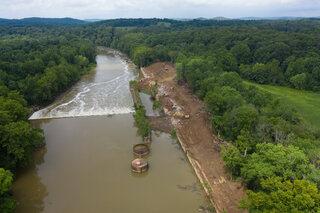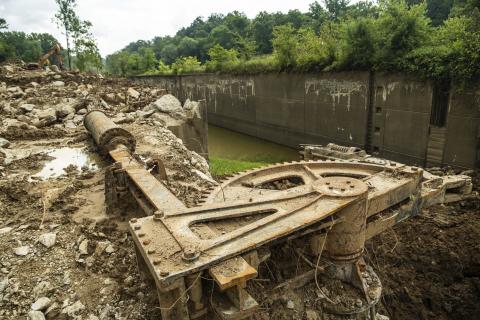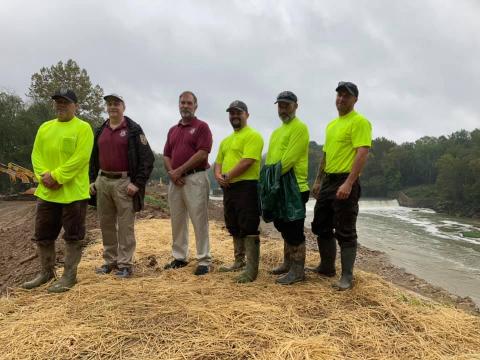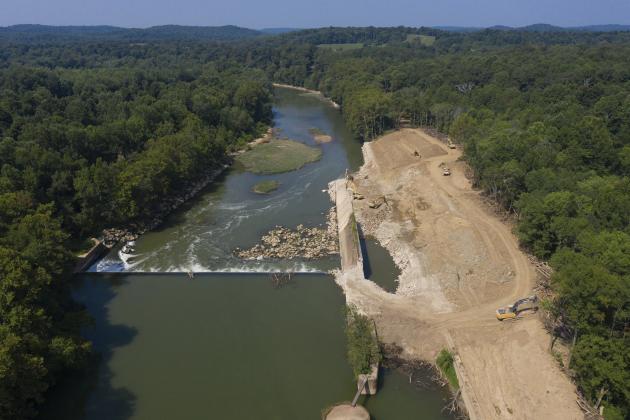Conservation Partners Celebrate Green River Dam Removal
Roundhill, KY | Sept. 20, 2021 — Today, five conservation partners celebrated the largest dam removal in Kentucky history—the demolition of Lock and Dam #5 on the Green River. The Butler County event brought together The Nature Conservancy, U.S. Fish and Wildlife Service, U.S. Army Corps of Engineers, Kentucky Department of Fish and Wildlife Resources, and Kentucky Waterways Alliance.

“Kentucky’s waterways form the backbone of our commerce, transportation, and recreation, but because of the Green River Dam – which sat unused since 1951 – that important natural asset was threatened. With the completion of today’s removal, we will finally return the Green River to its original, unimpeded state and reopen a crucial portion of the Commonwealth to boaters, sportsmen, and wildlife,” said U.S. Senator Mitch McConnell. “As Senate Republican Leader and a senior member of the Senate Appropriations Committee, I was proud to collaborate with local stakeholders to champion the 2016 Water Infrastructure Improvements for the Nation Act and subsequent appropriations measures for the U.S. Fish and Wildlife Service that made this removal project possible. I look forward to continuing my work to provide Kentuckians with the clean, healthy, and free-flowing water infrastructure we deserve.”

Green River Lock and Dam #5 was built in 1933-34 at river mile 168.1 for commercial use. The U.S. Army Corps of Engineers ceased operation of the structure in 1951. Since then, the structure has been unused, creating a pooled condition in the river with lower oxygen levels, more sediment, and higher temperatures – conditions that are detrimental for aquatic life and the overall health of the river. The dam also presents a barrier to boat traffic, and a public safety hazard. Removal will address all of these challenges.

“Removal of Lock and Dam #5 represents a triple win – a healthier, more accessible, and safer Green River,” said David Phemister, state director for The Nature Conservancy in Kentucky. “The largest dam removal in Kentucky’s history, this project is thanks to the hard work and leadership of many folks over more than seven years. We thank all involved, especially Senator McConnell, for delivering this win to the river and the local communities.”

The Green River is one of the most biodiverse rivers in the country, with more than 150 fish species and more than 70 species of mussels, including 43 endemic species—found nowhere else in the world. Imperiled species found in the Green River include nine endangered mussel species and one endangered freshwater shrimp (the Kentucky cave shrimp). The overall fishery will improve after the dam removal, including for highly sought-after gamefish such as smallmouth bass, rock bass, and muskellunge.

“We are excited to partner with the U.S. Fish and Wildlife Service and The Nature Conservancy on the removal of Green River Lock and Dam #5,” said U.S. Army Corps of Engineers Louisville District Commander Col. Eric D. Crispino. “This project will restore the natural flow to this portion of the Green River, the most environmentally diverse river in the inland navigation system, as well as support our ecosystem restoration mission. This project illustrates the concepts of partnerships and revolutionizing the U.S. Army Corps of Engineers, two priorities of the Chief of Engineers. The Louisville District is proud to be part of the partnership and we look forward to seeing the Green River free flowing again in a couple of months.”
Removal of the dam was made possible and specifically called for in the Water Infrastructure Improvements for the Nation Act or “WIIN,” championed by Senator McConnell in 2016. The $4.6 million dam removal is funded by the U.S. Fish and Wildlife Service National Fish Passage Program. Removal of the dam will restore free-flowing conditions to 73 miles of the Green River.
"Every time we remove one of these old structures, we're making connections,” said Leopoldo “Leo” Miranda-Castro, Director of the U.S. Fish and Wildlife Service’s South Atlantic, Gulf and Mississippi Basin Regions. “We’re connecting all sorts of species – fish, birds, plants and human beings – to a healthier environment. We’re connecting the river to its traditional path, too. As I mentioned when I last visited the site, it looks like a great fishing spot. So we’re connecting anglers to better fishing.”

The dam removal began in late June and is expected to continue through October. The dam is being removed by experienced dam removal personnel at the U.S. Fish and Wildlife Service, the Aquatic Habitat Restoration Team.
Facts:
•The removal of Green River Lock and Dam #5 is the largest dam removal in Kentucky history.
•Removing the lock and dam will result in a healthier river, a more accessible river, and a safer river.
•Lock and Dam #5 has stood unused for 70 years, creating a pooled condition in the river with lower oxygen levels, more sediment, and higher temperatures—all bad for aquatic life and the overall health of the river.
•The dam presents a barrier to boat traffic, with no portage or bypass options.
•Low head dams such as #5 pose public safety risks, and removal will make the river safer for people to enjoy.
•Removal will address all of these challenges with an immediate and permanent solution through the oval of the structure and repurposing of the surrounding lands.
•Removal of this dam was made possible and specifically called for in federal legislation championed by U.S. Senator Mitch McConnell. This federal legislation was signed Dec. 16, 2016, deauthorizing the dam from Corps inventory and directing its removal. (Water Infrastructure Improvements for the Nation Act
The $4.6 milliom dam removal is funded by the U.S. Fish and Wildlife National Fish Passage Program.million dam removal is funded by the U.S. Fish and Wildlife Service National Fish Passage Program.
•Green River Lock and Dam #5 was built in 1933-34 at river mile 168.1 for commercial use. Wooden barges hauled asphaltic sandstone mined at Kyrock for paving. Packet boats hauled other cargo in both directions, including early visitors to Mammoth Cave.
•The Corps ceased operation of the structure in 1951.
•GRLD5 consists of a 301-foot long dam, a 360-foot long by 56-foot wide lock chamber along the right descending bank, two approximately 30-foot diameter mooring cells located upstream of the lock chamber, a 266-foot long upstream guide wall, and a 300-foot long downstream guide wall.
•The dam is being removed by experienced dam removal personnel with the U.S. Fish and Wildlife Service, the Aquatic Habitat Restoration Team.
•Dam removal will restore free-flowing conditions to 73 miles of the Green River.
•Green River Lock and Dam #6 was removed in 2017. A total of 197 miles of the Green River will be restored to free-flowing conditions with both dams removed.
•Removal of dam will improve safety and access for recreational canoeists and kayakers.
•The overall fishery will improve after the dam removal, including for highly sought after gamefish such as smallmouth bass, rock bass, and muskellunge.
•The increase in recreational opportunities will benefit the local economy, including canoe liveries and businesses supporting local visitors.
•Dam removal will greatly benefit the ongoing Green River Blueway and Trail Town initiatives, which have been embraced by many small towns along the Green River and also by the Barren River Area Development District (BRADD).
•The Green River is one of the most biodiverse rivers in the country. It is home to more than 150 fish species, more than 70 mussel species, and 43 endemic species (species existing nowhere else in the world).
•Imperiled species found in the Green River include nine endangered mussel species and one endangered freshwater shrimp (the Kentucky cave shrimp).
•Many Green River species thrive in moving water and will benefit from dam removal. These include many aquatic insects that serve as food for foraging bats, including three bat species that are endangered.



























